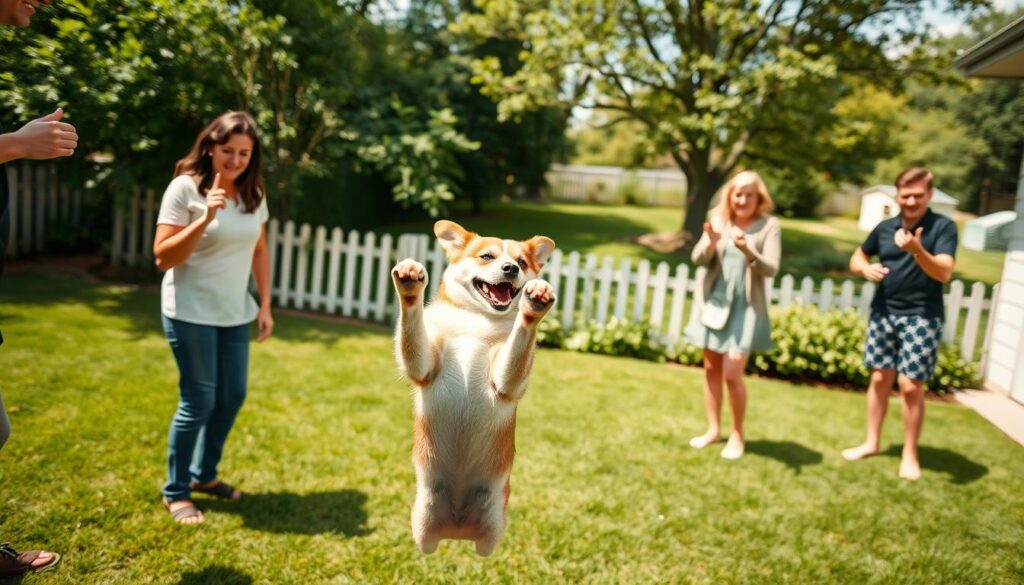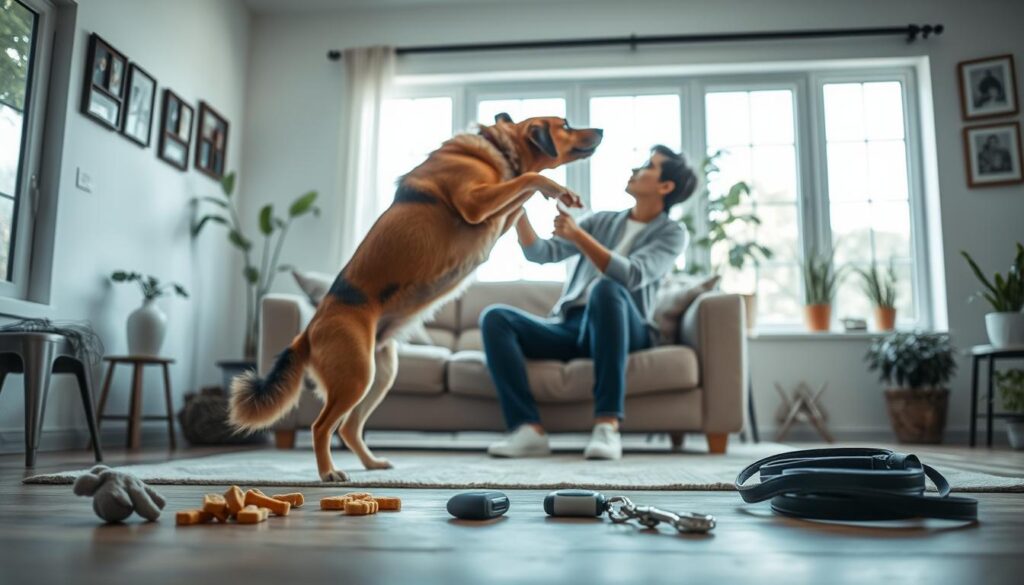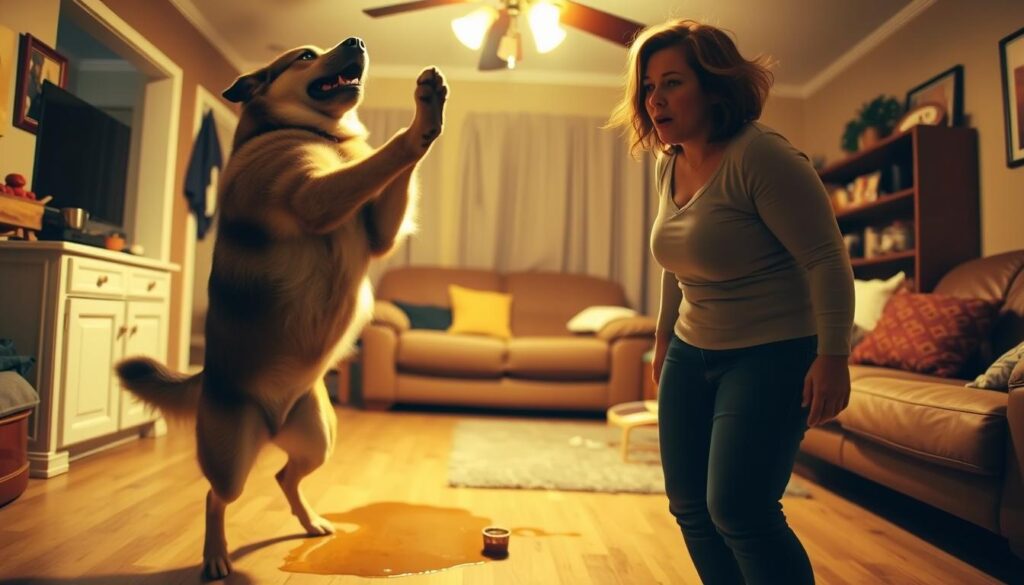As a dog owner, you might have felt frustrated when your dog jumps on people. This can be embarrassing and even dangerous, especially if your dog is big or very energetic. If you’re wondering how to stop your dog from jumping, you’re not alone. Many dog owners face this issue, but there are effective solutions.
We’ll explore why your dog might be jumping and give you practical tips. This way, you can teach your dog to behave politely around others.

Understanding why your dog jumps is key to solving the problem. By knowing what triggers this behavior, you can find a specific solution. With patience, consistency, and positive reinforcement, you can teach your dog to greet others politely. If you’re looking for ways to stop your dog from jumping, you’re in the right place. We’ll discuss the best solutions and provide a comprehensive guide to help you overcome this challenging behavior.
Key Takeaways
- Identify the underlying causes of your dog’s jumping behavior to develop an effective solution
- Consistency and positive reinforcement are key to teaching your dog to behave politely
- Understanding how to stop your dog from jumping on people requires patience and persistence
- Effective dog jumping solutions involve a combination of training, socialization, and management
- With the right approach, you can teach your dog to greet people calmly and respectfully
- Addressing jumping behavior early on can prevent more serious problems from developing
Understanding Why Dogs Jump on People
To tackle dog jumping, it’s key to know why it happens. Your dog might jump on people for natural greetings, excitement, or to get attention. Knowing this helps you find ways to stop it and make your home happier for both you and your dog.
Some main reasons for dog jumping include:
- Natural instinct: Dogs jump to greet people, like they do with their pack.
- Excitement and attention-seeking: They jump to get attention, love, or to play.
- Lack of training and boundaries: Without clear rules, dogs may jump to interact or seek attention.
Understanding these reasons lets you start teaching your dog not to jump. You can teach them to greet differently, like sitting or lying down. Also, setting clear rules and training helps them know what’s expected.

When trying to stop dog jumping, be patient, consistent, and positive. Understanding why your dog jumps and using good training methods can make them a better, happier pet.
The Risks of Allowing Your Dog to Jump on People
As a dog owner, it’s crucial to know the risks of letting your dog jump on people. Stopping your dog from jumping is key to avoid injuries, property damage, and strained relationships. By stopping your dog from jumping, you protect others and your dog from harm.
Some risks of dog jumping include:
- Injuries to people, especially children and the elderly
- Damage to property, such as furniture and clothing
- Strain on relationships with family and friends who may feel uncomfortable around your dog
To prevent dog jumping, you need consistent training and positive reinforcement. Teach your dog to sit or lie down instead. This way, you create a better environment for everyone. It’s important to start training early to avoid risks and strengthen your bond with your dog.

By preventing dog jumping, you protect others and your dog. Remember, consistent training and positive reinforcement are essential. They help stop dog jumping and make a more harmonious environment for all.
Essential Commands Your Dog Needs to Know First
Teaching your dog essential commands is key in dog behavior training. It helps stop unwanted actions like jumping on people. Start with basic commands to show your dog what’s expected. This way, you can fix the jumping problem and strengthen your bond.
Some vital commands to teach your dog are:
- Sit: This command teaches your dog to stay calm and not jump up.
- Stay: It builds on the sit command, showing your dog to stay put, even when distracted.
- Leave it: This command helps your dog leave things or people alone, useful when they might jump up.
- Down: Teaching your dog to lie down helps them relax and not jump up.
- Come: This command is crucial for off-leash walks and recalling your dog if they jump up.
- Wait: It teaches your dog self-control, helping them not jump up at people or things.
Learning these commands will help you tackle the jumping issue and raise a well-behaved dog. Always use positive reinforcement and be patient with your dog as they learn.
How Do I Stop My Dog From Jumping on People: Step-by-Step Training
To stop your dog from jumping on people, you need to understand it’s a behavior that can be controlled. Proper training and consistency are key. It takes patience, persistence, and positive reinforcement to teach your dog to avoid jumping.
Establishing the Four-Paws-on-Floor Rule
The first step is to teach your dog to keep all four paws on the floor. This rule is in place unless they’re invited to jump. Reward your dog for calm behavior and ignore them when they jump.
Using Positive Reinforcement Techniques
Positive reinforcement is crucial in teaching your dog not to jump. Treats, praise, and affection for calm behavior encourage good manners. Training consistently helps avoid confusion and ensures your dog knows what’s expected.
Here are some important tips for training your dog: * Be consistent with commands and rewards. * Never use physical punishment or negative reinforcement. * Focus on positive reinforcement to encourage good behavior. * Always be patient and persistent in your training.
Managing Greetings at Your Front Door
Trying to stop your dog from jumping on people can be tough, especially at the front door. Dogs often get excited and jump on visitors here. It’s important to teach them a calm and polite way to greet.
Training your dog to sit or stay when the doorbell rings is key. Use the “four-paws-on-floor” rule. Reward them for keeping all four paws on the ground.
Here are some tips for managing greetings at your front door:
- Train your dog to respond to a “quiet” or “settle” command to help them calm down when they get excited.
- Use positive reinforcement techniques, such as treats and praise, to encourage good behavior.
- Consider setting up a “waiting area” where your dog can wait calmly before greeting visitors.
Follow these tips and always reward good behavior. This will help your dog learn to greet visitors calmly. Remember, changing your dog’s behavior takes time and effort. Be patient and consistent.
Addressing Jumping Behavior During Walks
When walking your dog, it’s key to stop jumping to keep both you and your dog happy. Start by teaching your dog to walk beside you without pulling. Use treats and praise to reward calm walking.
It’s also important to handle unexpected meetings with other dogs or people. Teach your dog to “sit” or “stay” to stay calm. This way, they won’t jump up. Teach them not to jump on people by rewarding good behavior and ignoring bad.
Some key strategies for addressing jumping behavior during walks include:
- Practicing leash training basics to prevent pulling on the leash
- Using positive reinforcement techniques to encourage good behavior
- Teaching your dog to “sit” or “stay” on command to handle unexpected encounters
- Consistently reinforcing good behavior and ignoring bad behavior to teach proper greeting etiquette
By following these strategies and using effective training tips for dog jumping, you can help your dog become a well-behaved walking companion and reduce the occurrence of jumping behavior.
Special Considerations for Different Types of Dogs
Preventing your dog from jumping requires understanding their unique needs. This includes puppies, adult dogs, high-energy breeds, and senior dogs. Each needs a tailored training approach.
Consider your dog’s age, breed, and energy level when training. Puppies need more training and positive feedback. Adult dogs need consistent rules and exercise. High-energy breeds like Australian Shepherds need lots of activity to stop jumping.
Training Puppies
Puppies are full of energy and curiosity. Start training early to stop jumping. Use treats and praise to encourage good behavior.
Managing High-Energy Breeds
High-energy breeds need lots of exercise and mental games. Activities like agility training or long walks help keep them busy.
Caring for Senior Dogs
Senior dogs need gentle training due to mobility issues. Keep training sessions short and reward good behavior with praise and treats.
Understanding your dog’s needs helps you train them effectively. This strengthens your bond and prevents jumping.
| Dog Type | Training Approach |
|---|---|
| Puppies | Positive reinforcement, frequent training sessions |
| High-Energy Breeds | Regular exercise, mental stimulation, agility training |
| Senior Dogs | Gentle training, short sessions, plenty of praise and rewards |
Common Mistakes to Avoid When Training
Consistency is crucial in dog behavior training. If you’re not consistent, your dog might get confused. This makes it harder to teach them not to jump on people.
One big mistake is punishing your dog for jumping. This can make them associate jumping with bad things. It makes training harder.
Another error is not using positive reinforcement. Rewarding your dog with treats and praise helps a lot. Without it, they might not know what you want them to do.
Here are some common mistakes to steer clear of in dog training:
- Inconsistency in training
- Punishing your dog for jumping
- Lack of positive reinforcement
To avoid these mistakes, use positive reinforcement. Be patient and consistent. With time and effort, your dog will learn not to jump on people.
Working with Professional Trainers and Behaviorists
If your dog’s jumping is a problem, it’s time to get help. A professional trainer or behaviorist can help you understand why your dog jumps. They will create a training plan just for your dog.
Stopping dog jumps takes patience and consistency. A pro can teach you how to use positive methods to encourage good behavior. They’ll help you make a training plan that fits your dog’s needs and personality.
Working with a professional trainer or behaviorist has many benefits. Here are a few:
- Customized training plans
- Positive reinforcement techniques
- Improved communication with your dog
- Increased confidence in your ability to control your dog’s behavior
By getting help from a professional, you can learn to control your dog’s jumping. This will also make your bond with your pet stronger. Make sure to pick a trainer who uses positive methods and has experience with dogs like yours.
Conclusion: Creating Lasting Change in Your Dog’s Behavior
Stopping your dog from jumping on people is a journey that needs time, patience, and consistent effort. Learning commands like “sit” and “stay” and using positive reinforcement are key. It’s also important to address the reasons behind the behavior, manage greetings, and seek help from trainers if needed.
Your dedication to training and setting clear rules will help your dog learn how to greet people correctly. This way, everyone will be safe and happy. Keep going, celebrate the small wins, and enjoy the closer bond you’ll form with your dog. With your help, your dog will become a well-behaved and friendly companion for all.
FAQ
Why does my dog jump on people?
Dogs jump on people for a few reasons. They might do it as a natural greeting. They could also jump out of excitement or to get attention. Not teaching them proper manners is another reason.
What are the risks of allowing my dog to jump on people?
Letting your dog jump on people can be risky. It might hurt them or damage things. It can also strain relationships. It’s key to teach them not to jump to keep everyone safe and happy.
What commands should my dog know to prevent jumping?
Your dog should know a few important commands. These include sit, stay, leave it, and come. Learning these commands helps you control their behavior and stop them from jumping.
How do I train my dog to stop jumping on people?
To stop your dog from jumping, start with the four-paws-on-the-floor rule. Use positive rewards to encourage good behavior. Being consistent in your training is also crucial.
How can I manage greetings at my front door to prevent jumping?
To handle greetings at your door, teach your dog to wait calmly. Reward them for good behavior. Having a set greeting routine helps them learn to greet politely.
How do I address jumping behavior during walks?
To handle jumping on walks, focus on leash training. Teach them how to behave when they see other dogs or people. This keeps them calm and well-behaved.
Are there any special considerations for different types of dogs?
Yes, different dogs need different approaches. Puppies, adult dogs, high-energy breeds, and seniors all have unique needs. Tailoring your training to your dog’s specific needs can be more effective.
What are some common mistakes to avoid when training my dog?
Avoid being inconsistent, punishing your dog, and not using positive reinforcement. Focusing on these areas helps ensure your training is effective.
When should I seek professional help for my dog’s jumping behavior?
If your dog’s jumping doesn’t stop, even with your best efforts, get professional help. A trainer or behaviorist can offer personalized advice and support.
